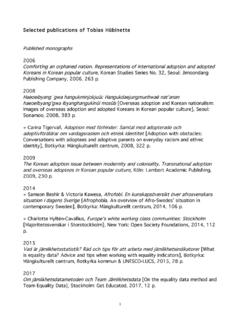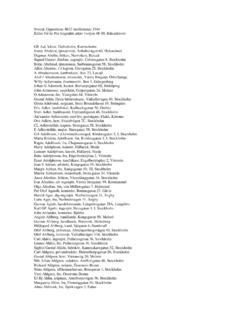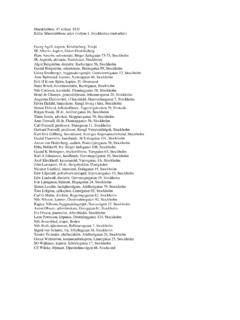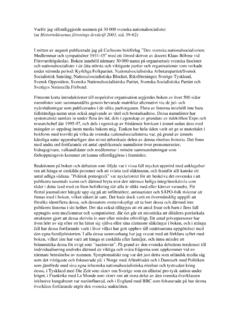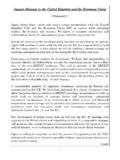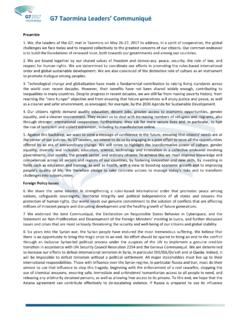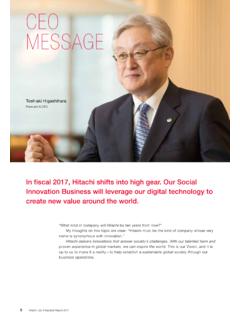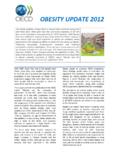Transcription of What Is the K in K-pop? South Korean Popular …
1 What Is the K in K-pop? South Korean Popular Music, the CultureIndustry, and National IdentityJohn Lie*In the early 2010 s, the expansion of South Korean Popular culturearound the world is led by Popular music, usually known as K-pop. In this paper I seek to answer two questions. First, what arethe sources of its success beyond the South Korean national border?Secondly, what does it say about contemporary South Korean societyand culture?Key Words:K-pop, Korean Wave, Hallyu, South Korean PopularCulture, Popular MusicI. IntroductionThe phenomenal success of the Korean Wave has generated collec-tive celebration in South the early 2010s, the national self-339* John Lie is Cho Professor of Sociology at the University of California,Berkeley, He received his in Sociology from Harvard forthcoming books include The Global Universityand The Consolation of SocialTheory.
2 E-mail: The Korean Wave is the literal translation of the term which originated inChina ( ; H nli ). The first character refers to Korea and the second usuallyevokes flow or current, signifying style. The same Chinese characters KOREAOBSERVER, Vol. 43, No. 3, Autumn 2012, pp. 339-363. 2012 by THE INSTITUTE OF Korean STUDIES. (43-3_2012) 3:3 PM 339congratulation is especially manifest for the popularity of South Koreanpopular music (K-pop), which has spread from neighboring Asiancountries, such as japan and Taiwan, to farther ashore in Europe, theAmericas, and the Middle K-pop World Festival in Decem-ber 2011 attracted wannabe K-pop singers from sixteen differentcountries and confirmed its global appeal to South Koreans (Choe andRussell, 2012).
3 K-pop news generate media headlines. The SouthKorean government, intent on enhancing its soft power along with itsexport prowess, has actively promoted K-pop. Many younger SouthKoreans are eager to embrace the global success of K-pop, whichsomehow proves the creativity and coolness of South Koreans, hithertoknown for producing cars and cell phones rather than engrossingdramas and Popular songs: diligence and intelligence rather thanbeauty and style. K-pop in particular and the Korean Wave in generalraise a wide range of questions, but I focus on two. What are thesources of K-pop s recent commercial success? What does it say aboutSouth Korean society and culture?
4 II. Cultures of Choson KoreaAny effort to make sense of culture is fraught with difficulties,beginning with the concept of culture. Do we mean the greatestachievements of the elite or the least common denominators of thepeople?3 The very idea of an integrated culture or a (culturally) unifiedpeople is also something of a dubious proposition in most places andtimes before the advent of the modern nation-state (Lie, 2004). Be thatas it may, taking the latter half of the long Choson-dynasty period340 John Lieyield Hallyu in Korean and Kanryu in Japanese. See Paek (2005).2. See inter aliaon K-pop s popularity in France, Le Monde M Magazine, February3, 2012; Cambodia, The Economist, February 18, 2012; and japan , Sakai (2012:14-23).
5 For a useful overview, see Abe (2012).3. This contrast is neatly summarized by two late nineteenth-century Britishwritings: Matthew Arnold s Culture and Anarchy(1869) and E. B. Tylor s PrimitiveCulture(1871). (43-3_2012) 3:3 PM 340(1392-1897), we can identify two distinct cultures, albeit with consid-erable commonality in elite culture was dominated by Chinese-influenced, Confu-cian-drenched monarchy and the yangbanruling class. The Sinocentricworldview valorized classical Chinese civilization, conveniently sum-marized in this period as being Confucian, with its stress on respect-ing the elders and ancestors, hierarchy and patriarchy, and traditionand order.
6 In contrast, in spite of its regional variations, the culture ofthe masses or the peasantry tended to be much more egalitarian anddisorderly. To put it in a shorthand form, then, the Confucian ritualsof the elite all quiet and orderly contrasted with the shamanisticrites of the masses emotional and expressive. In terms of music, thecourtly performances of Chinese-derived instruments stood in sharpcontrast to the Popular performances of folk tunes and drums. Theformer seemed to be all about harmony and order; the latter appearedto exemplify energy and chaos. To invoke the European categories ofcontrast: Apollonian vs. Dionysian. The ideal-typical contrast exag-gerates the distance between the two musical cultures.
7 Both traditionswere broadly pentatonic, in line with much of Asia. Furthermore, theConfucianization of the Korean peninsula during the long dynasticrule integrated the soundscape (Deuchler, 1992). At times, the influ-ence flowed upward: pansori recitation accompanied by a drum which began as a Popular genre became increasingly prestigious andembraced by the Confucian elite (Pihl, 1994).In practice, by the beginning of the twentieth century, there wassomething of a common musical culture in the Korean peninsula. Itsmusical register was pentatonic, itself a regional marker across EastAsia. The dominant singing style stressed emotive wails and melis-matic expressions.
8 While dancing, both in its courtly and countryarticulations, existed, it was placed explicitly outside the boundary ofmusic. Singers by and large stood still during their vocal perfor-mances. The body was Confucian: not only preserving the parentalgift but also avoiding any display of the flesh. The singer s still andenveloped body expressed serious, spiritual message in the form ofmoralizing lyrics, such as parental and familial love. The sensibility ofWhat Is the K in K-pop? 341 (43-3_2012) 3:3 PM 341 Korean music, then, was in harmony with the cultural sensibility ofConfucian The Advent of the ModernIn one reading of post-traditional, post-Choson-dynasty Korea,the incursion of the modern primarily through japan before theLiberation and the United States after 1945 signaled a relentlessretrenchment of the traditional.
9 In the realm of music, the simplereading captures the dominant trend: traditional music gave way toJapanese and Western genres. The Popular that had been equivalentto the folk receded as the new Popular music, itself more a productof the culture industry rather than an emergent expression of thepeople, reverberated throughout the the 1876 Treaty of Kangwha opened the Hermit Kingdom to Western influences, then the brute reality of power politics meantthe predominance of japan until the end of the colonial period. It islargely through Japanese channels that urban Koreans becameattuned to Western musical forms, from classical music to popu-lar genres such as ballads and is not that Western musicwas merely emulated in japan or Korea.
10 As I elaborate below, thepentatonic scale continued to dominate in contradistinction to thediatonic of Western Popular music and lyrics were translated,adapted, and created to fit local sensibilities. It is possible to argue thatJapanese enkaor Korean trot[t u rot u ] emerged as a fused and musicalgenre, somewhat as African and European music forms generatedblues and bluegrass, jazz and country in the United States (Van DerMerwe, 1989). Given the Japanese rule over Korea including culturalproduction and musical education the Japanese influence overKorean musical sensibilities was John Lie4. japan had actively attuned itself to Western sounds from the mid nineteenthcentury, colonizing the soundscape of the educated population by the earlytwentieth century.
